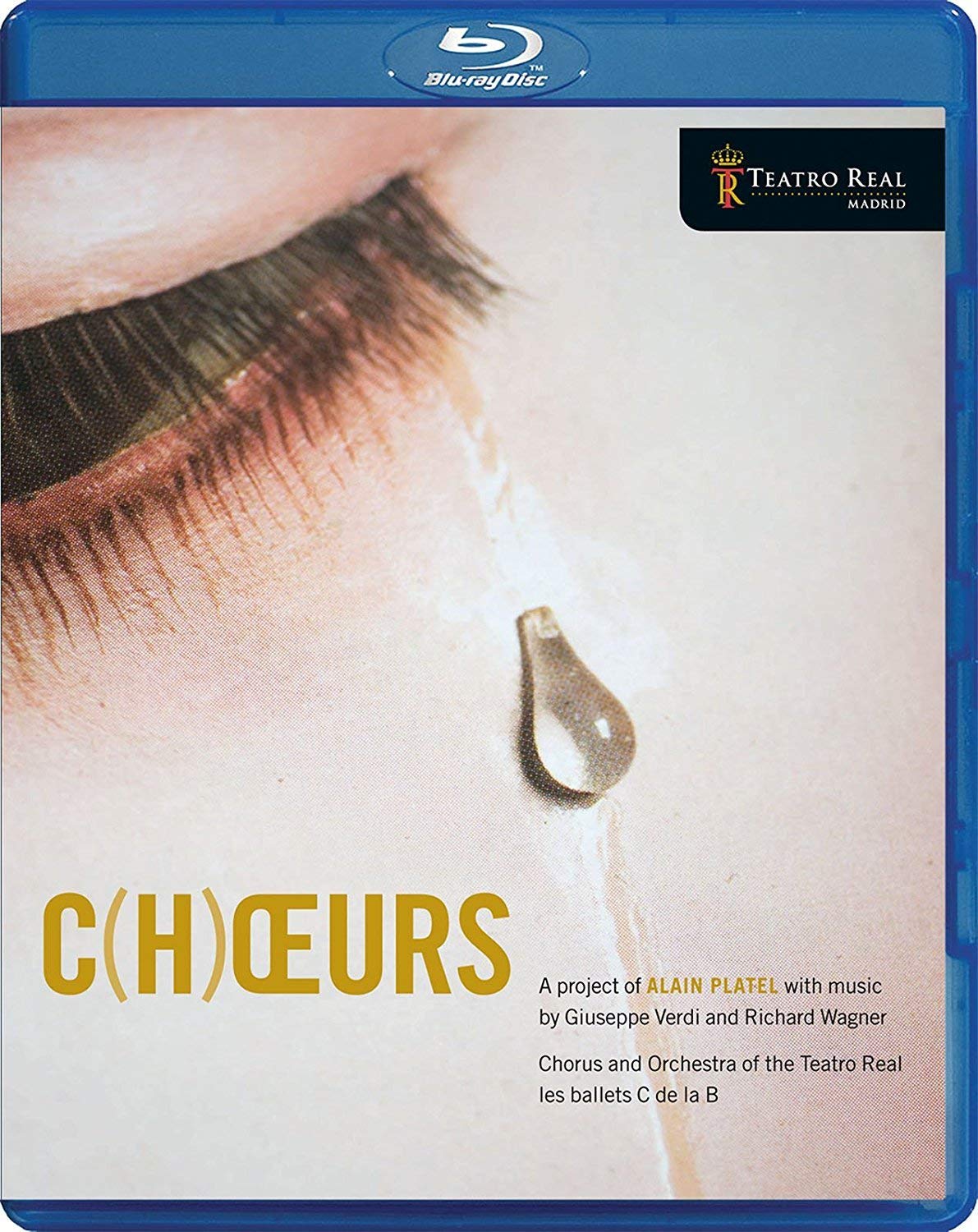
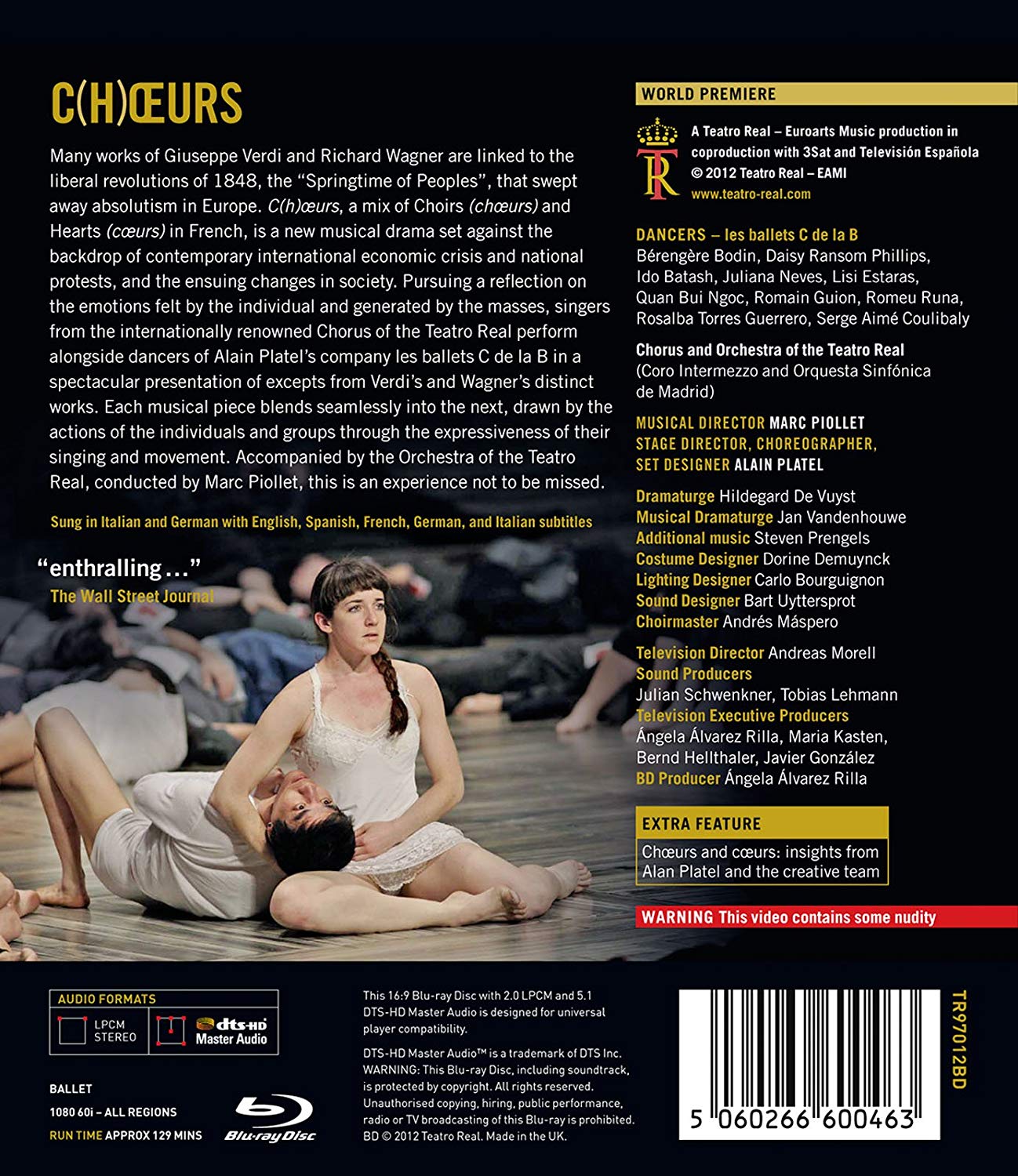
C(H)ŒURS ("Choirs/Hearts") dance production. Choreographed and directed 2012 by Alan Platel at the Teatro Real in Madrid. Music by Verdi and Wagner; additional music by Steven Prengels; short spoken part with words of Desmond Tutu. Features dancers from Patel's dance company, les ballets C de la B: Bérengère Bodin, Daisy Ransom Phillips, Ido Batash, Juliana Neves, Lisi Estaras, Quan Bui Ngoc, Roman Guion, Rumeu Runa, Rosalba Torres Guerrero, and Serge Aimé Coulibaly. The other star of this show is the Chorus of the Teatro Real (and individual members thereof). Consuelo Garres is a chorus member who sings solo. Two boys, Martin López Malgesini and Nicolás Del Real Sasaki, join the Chorus for special roles. Marc Piollet conducts the Orchestra and Chorus of Teatro Real (Madrid Symphony Orchestra and Chorus) with Choirmaster Andrés Máspero. Dramaturgy by Hildegard De Vuyst; musical dramaturgy by Jan Vandenhouwe; costume design by Dorine Demuynck; lighting design by Carlo Bourguignon; sound design by Bart Uyttersprot. Directed for TV by Andreas Morell; Sound Producers were Julian Schwenkner and Tobias Lehmann; Blu-ray Producer was by Ángela Állvarez Rilla. Released 2012, disc has 5.1 dts-HD Master Audio sound. Grade: A
The world premiere of C(H)ŒURS (always spelled in all caps) was on March 12, 2012, and this film was made several days later. According to the press release, this was "a new musical drama set against the backdrop of contemporary economic crisis and national protests and the ensuing changes in society." We also read that les ballets C de la B (originally called "Les Ballets Contemporains de la Belgique") is a well-established, avant-garde, multi-discipline corps with a political and philosophical bent. (Is it possible for an arts organization to be both "well-established" and "avant-garde"?) It might be said that les ballets C de la B is a French culture analog to the German Tanztheater of Pina Bausch.
Well, anything by les ballets C de la B will be interesting if you can figure it out. To help you with this, Hildegard De Vuyst wrote 4 pages in the keepcase booklet explaining C(H)ŒURS. This might be the most elaborate exercise in fuzzy thinking we ever have encountered. Executive briefing: the choreographer is unhappy about the way things are going.
But there's nothing fuzzy about the show. First, there is wonderful music from a huge symphony orchestra. Then there are modern dance stars who also act, speak, and sing plus the special twist of adding an excellent opera choir, the members of which are also coached to act and do surreal stuff. The result is easily the wildest, most provocative, and challenging dance title published to date in Blu-ray (June 2018).
The videography comes from Andreas Morell, whom we have praised to the moon for his work in the LINES title from Alonzo King and the gorgeous Caravaggio recording from Unter den Linden, Berlin. The PQ, SQ, and picture content in subject title are all super.
Of the 9 dancers, we've been able to match up the bodies and names for Daisy, Lisi, and Rosalba. But despite hours of surfing the Internet, we still can't accurately name the other 6. They are all so weird and wonderful. We would like to name them correctly in the screenshots. If you know the European contemporary dance scene well enough to ID all the dancers, please let us know. They all should get better credit than they do on the disc keepcase.
Let's get going with some screenshots. The dancers are introduced first, one by one, and each in a unique way:
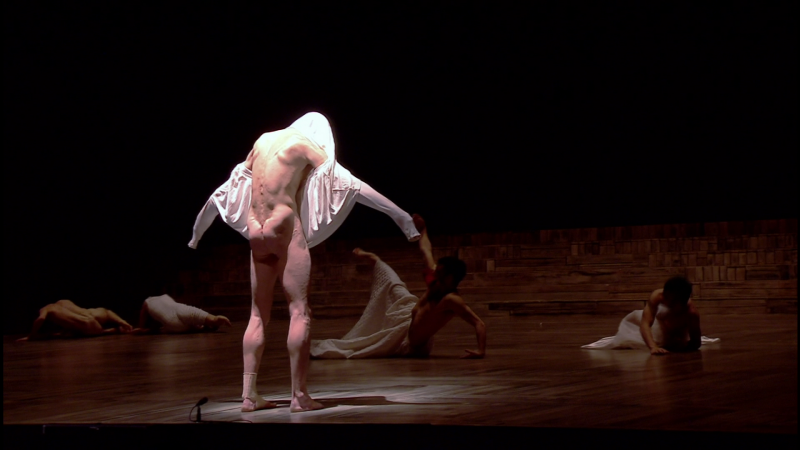
Most of the dancers have their underpants folded in a neat bundle, and they carry the bundle between their teeth:
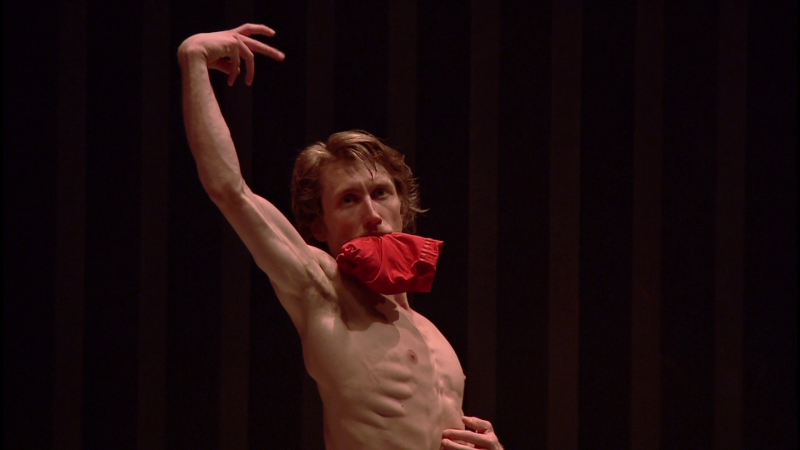
Eventually they gather and there is a terrible commotion as they try to put their underpants on while shaking violently as if afflicted by some terrible illness. This dimension of the scene can't be appreciated from a still photo:
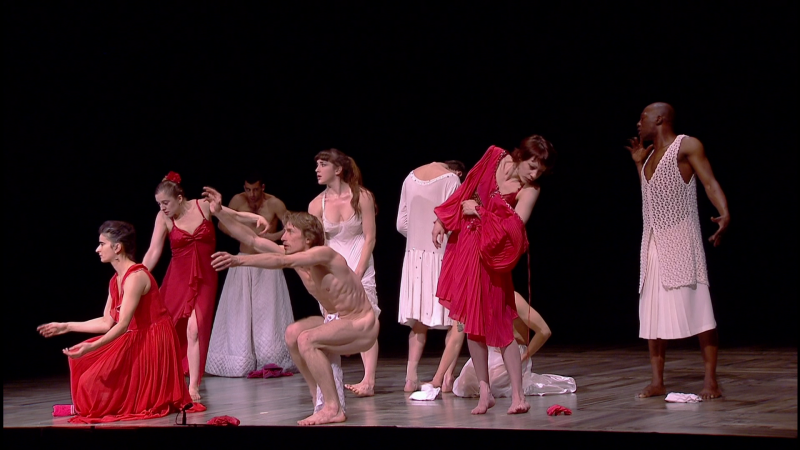
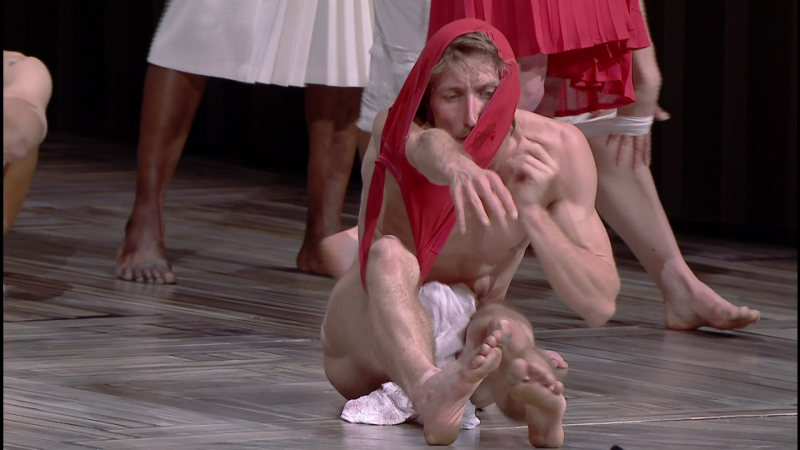
Now everybody is finally dressed and ready for action:
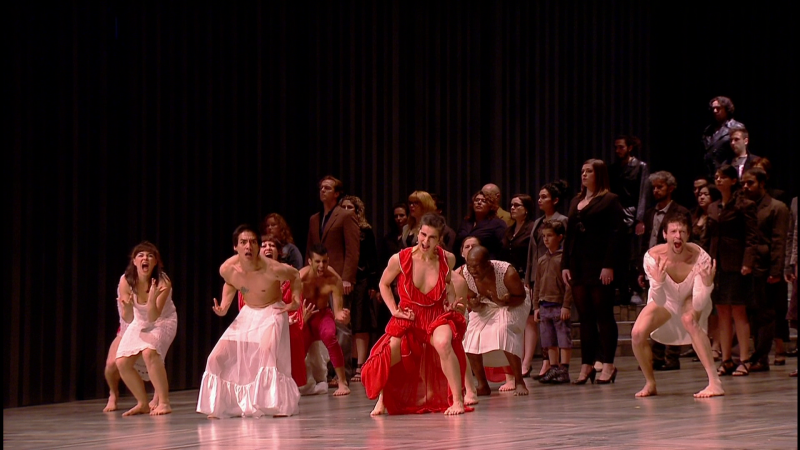
The chorus comes on stage and they are ready for action too. They declare "I love you" in several sign languages. We don't know for sure what the hand sign pictured below means in Brussels or Madrid with the thumbs holding down the middle and ring fingers. But we do know this is the official fighting sign of sports fans at the University of Texas! The UT mascot is a longhorn steer. The little and index fingers are the horns! (Just to be generous, Alan Platel is hereby granted permission by several citizens of Texas to use the UT fighting sign in any of his ballets.)
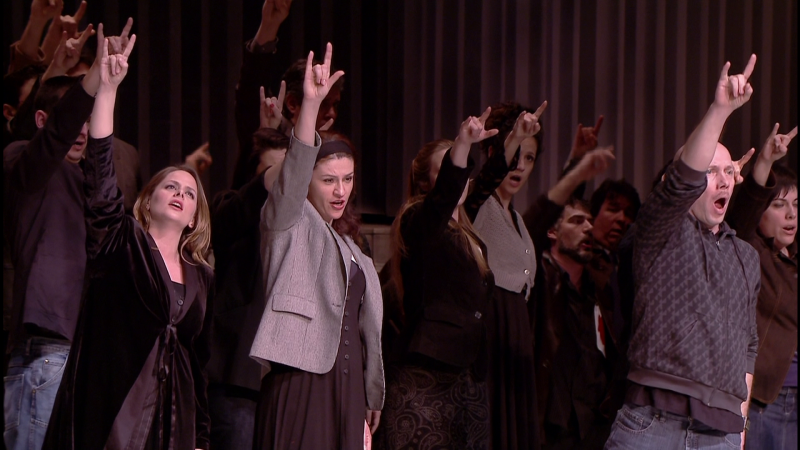
Then each member of the chorus takes off his jacket and we see a heart, or is it a target, or is it a bleeding wound?
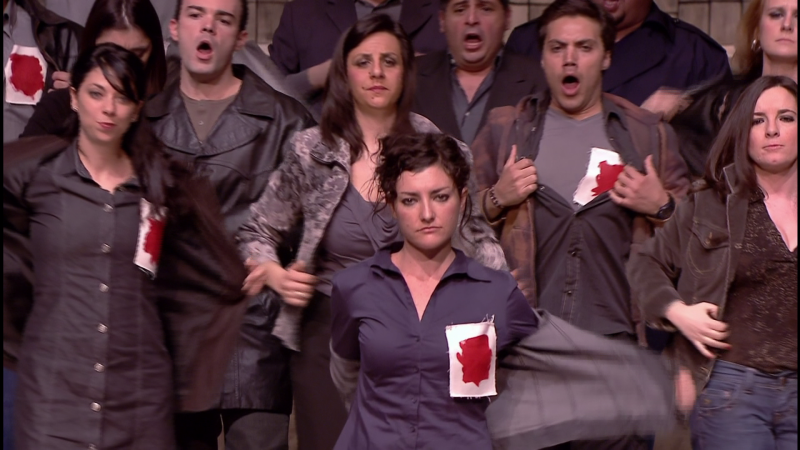
Now we get into some philosophy:

We are some very intense dancers and a bunch of opera singers who are starting to act like performance freaks:
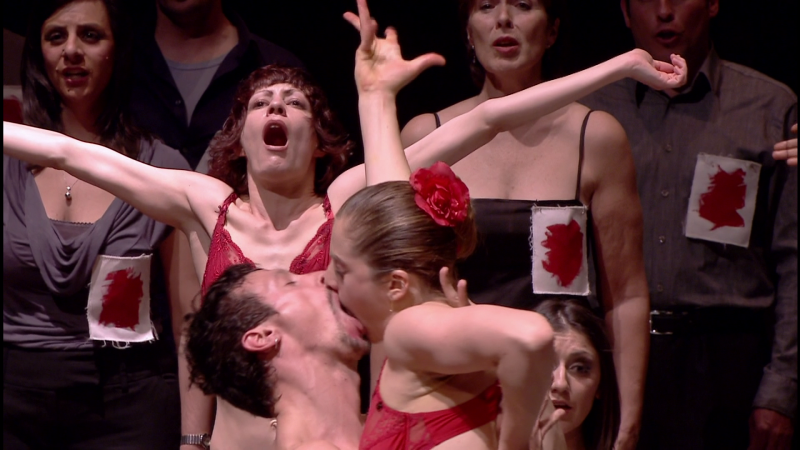
There are two little boys on stage representing, we assert, hope. The boy here is hoping these half-naked people running around are not cannibals who plan to roast him for dinner:
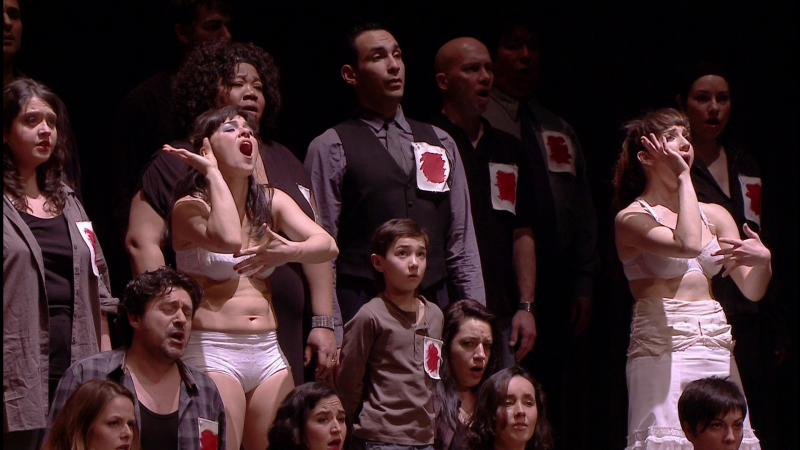
Different contingents from the chorus follow the dancers in wild atavistic displays:
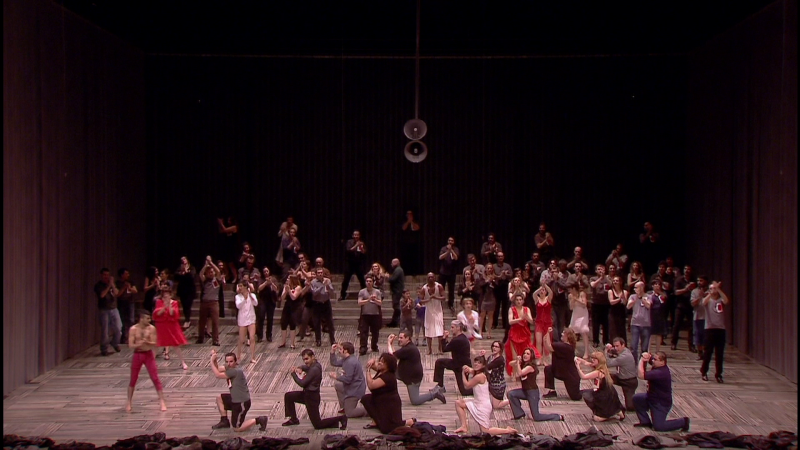
You have to be flexible if you join an opera chorus:
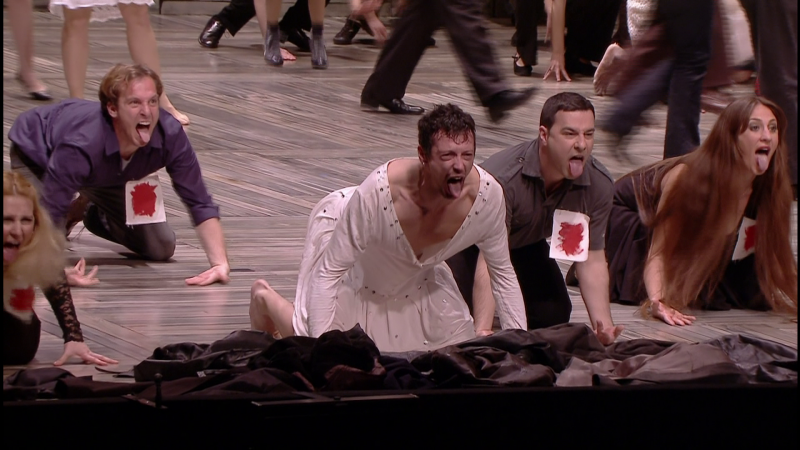
In some parts of the world, the greatest insult possible is to throw your shoes at someone. So here everyone throws his shoes at the rest of the world:
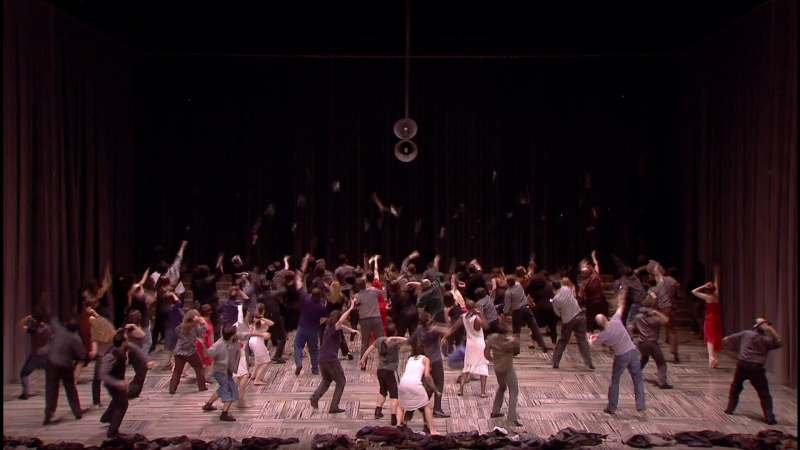
In this scene, the dancers all lie on the floor:
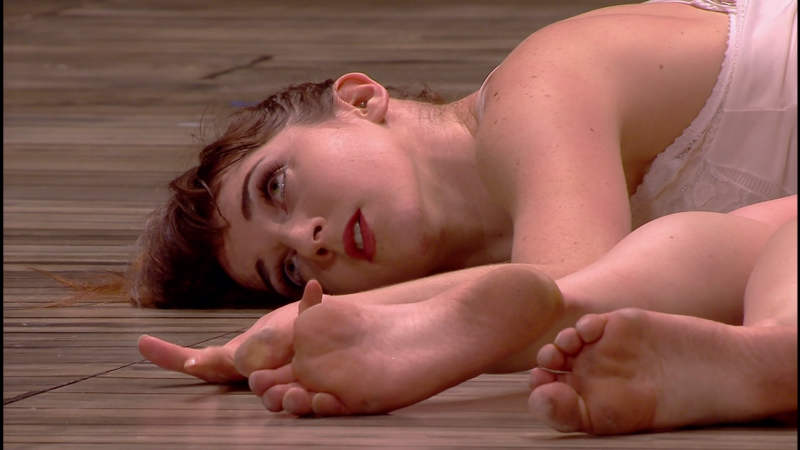
Or pull up their skirts with their teeth:
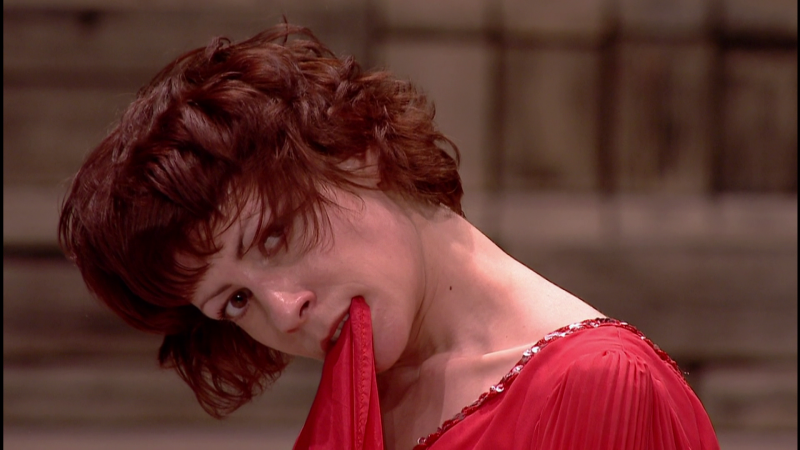
Now the show becomes a kind of political meeting. The Mistress of Ceremonies in red has one of the most beautiful speaking voices you ever heard. She keeps coming up with interesting comments and propositions for the crowd:
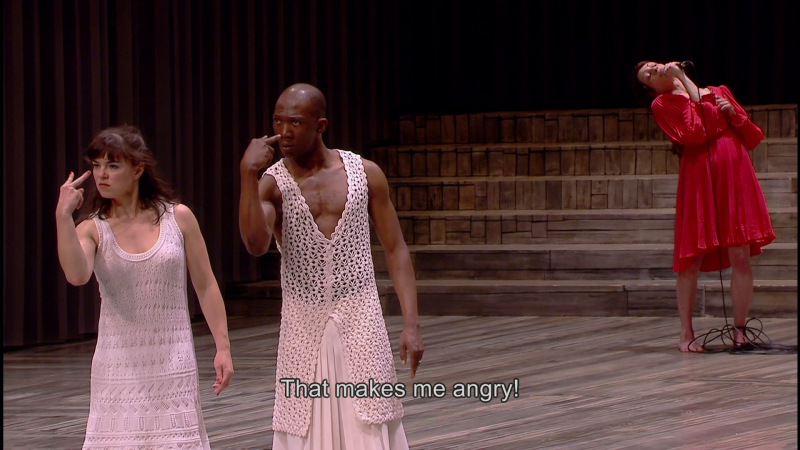
Shards of ideas careen through the air/Spunsense and unsense litter everywhere. Here's what one member of the crowd thinks about politicians:
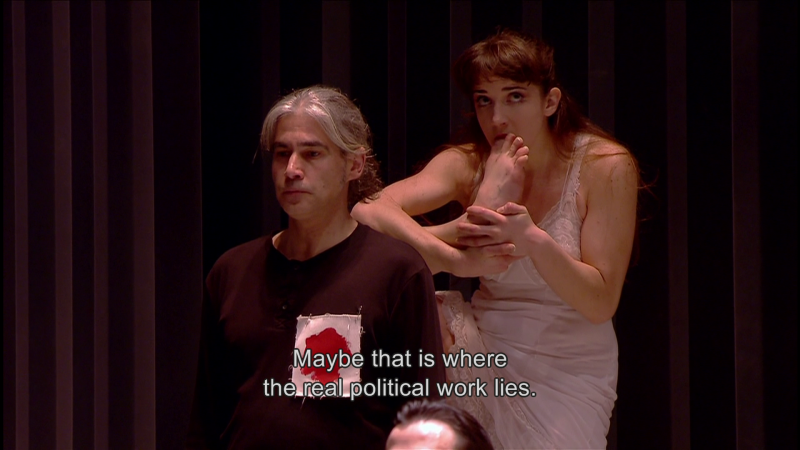
A square-dance:
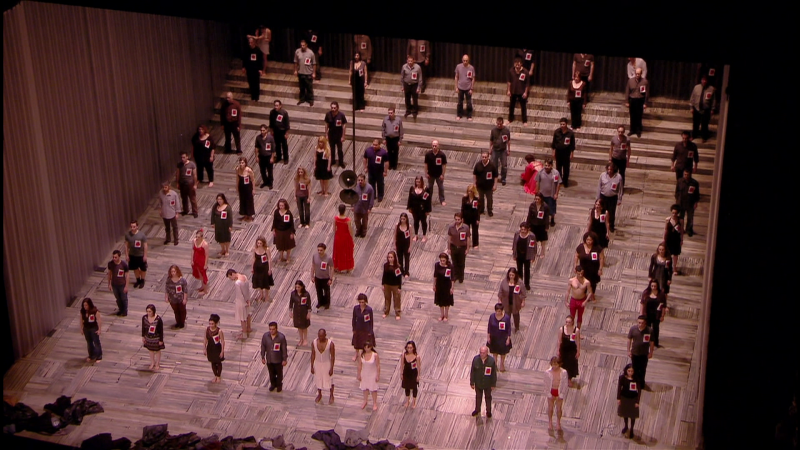
Another order from the Mistress of Ceremonies:
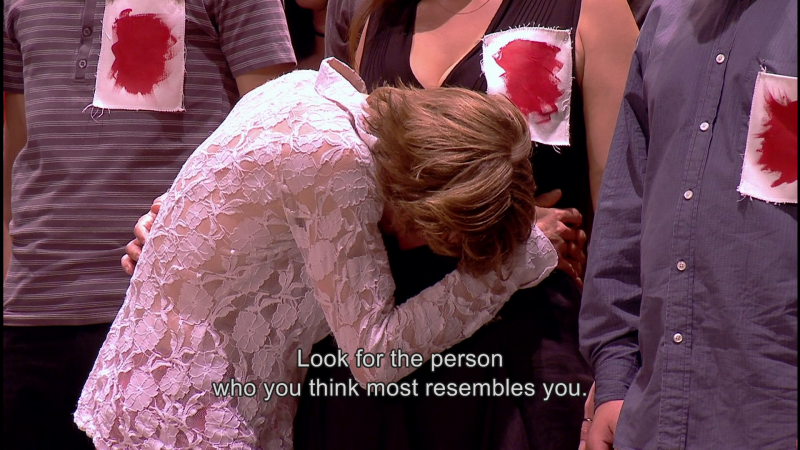
Two of the dancers look like sisters:

While chorus members try to make you think, the twisted sisters command attention with profuse strains of wild performance art:
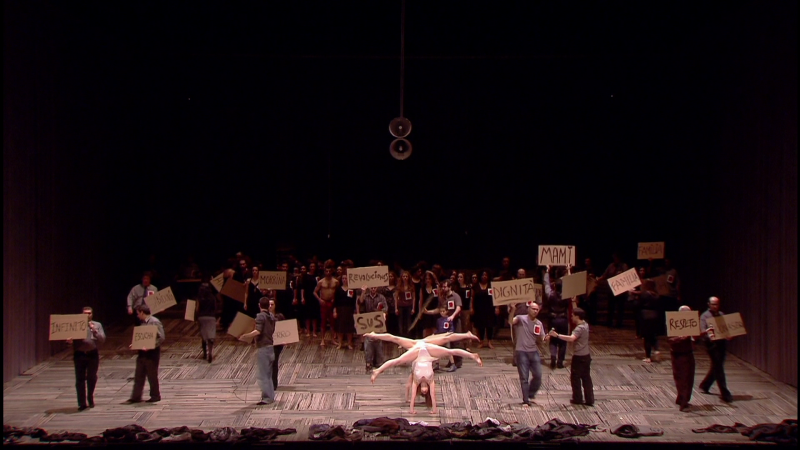
The little boys are borne away (I guess) as a symbol of perished hopes:
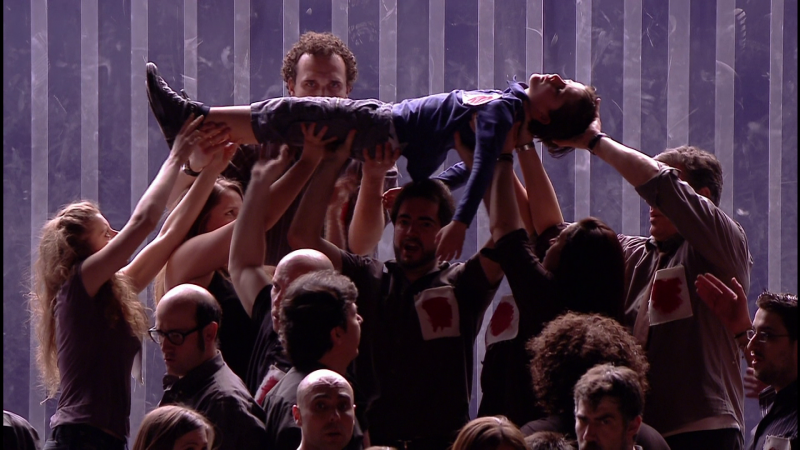
Amidst all the the clamour, suddenly we get a serene, classical image such is this:
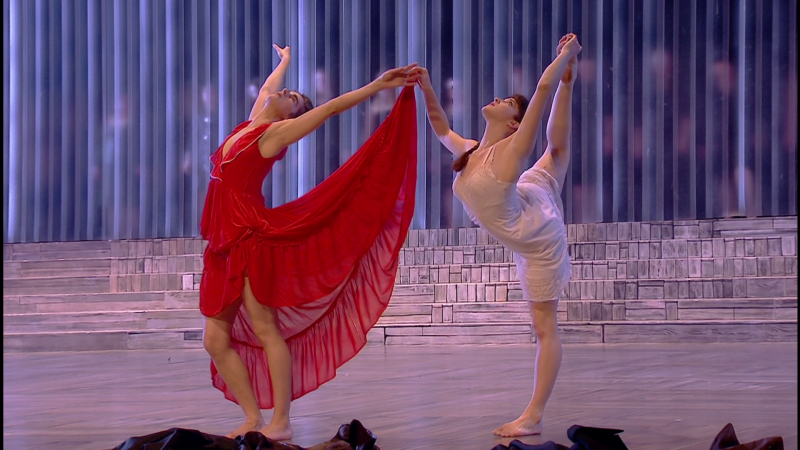
But mostly we are treated to more bizarre gyrations:
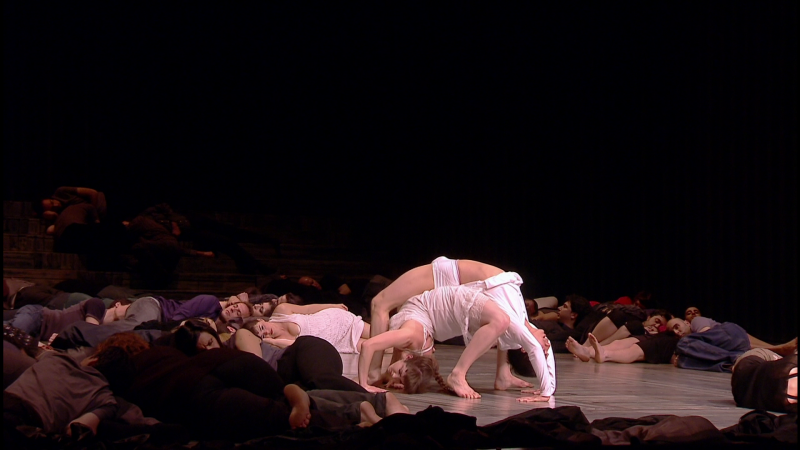
Close to the end are passages from the Verdi Messa da Requiem with Consuelo Garres as soloist:
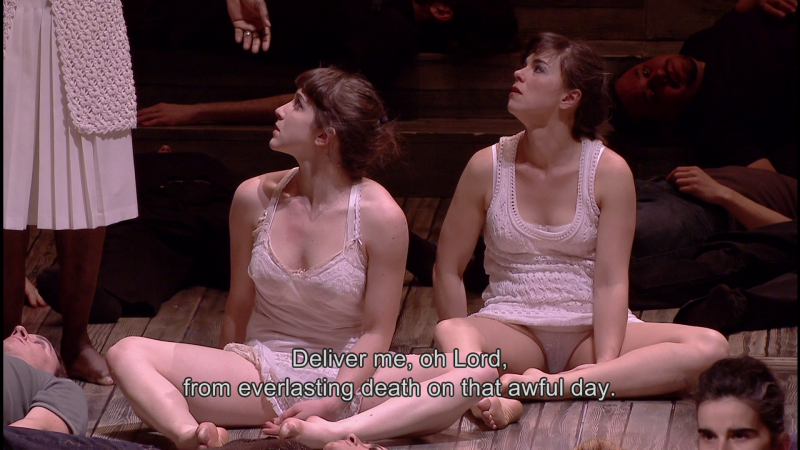
The dancers decide to go to judgment pure (in the buff): They will exit the stage at the rear, which avoids frontal nudity.
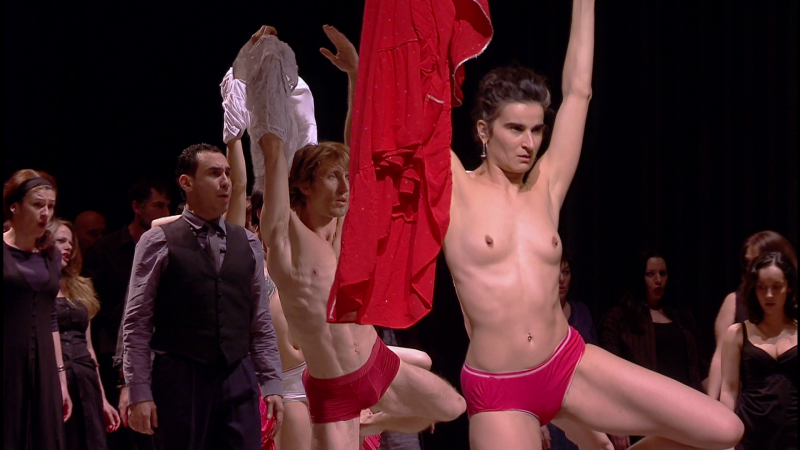
I get the impression that chorus members were given in each performance the options of staying on stage or heading for the rear. Those leaving early could show sympathy for the dancers (by taking off this or that) or demonstrate complete solidarity. Possibly each chorus member waited until the exodus to make his or her decision. Here we see three chorus ladies heading for the rear:
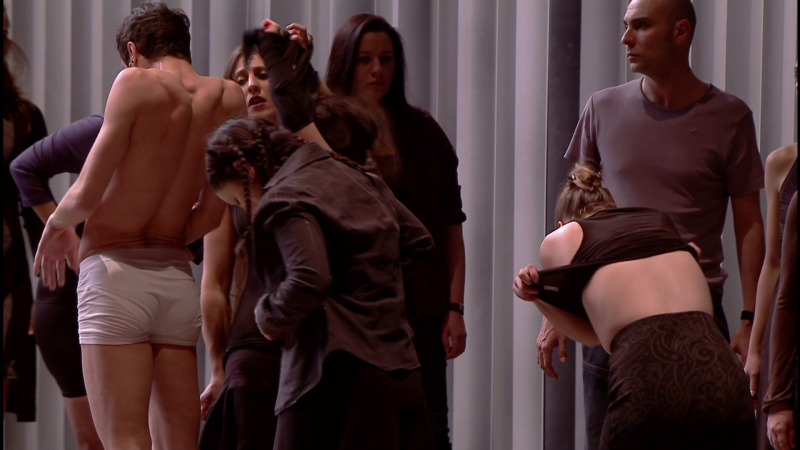
In the last two views, the soloist Garres (in black) is wisely facing the audience; other performers are resolutely retreating. I don't know how many times the scene got played in Madrid in 2012, but this was definitely a finale that no member of the Teatro Real Opera Chorus will ever forget!
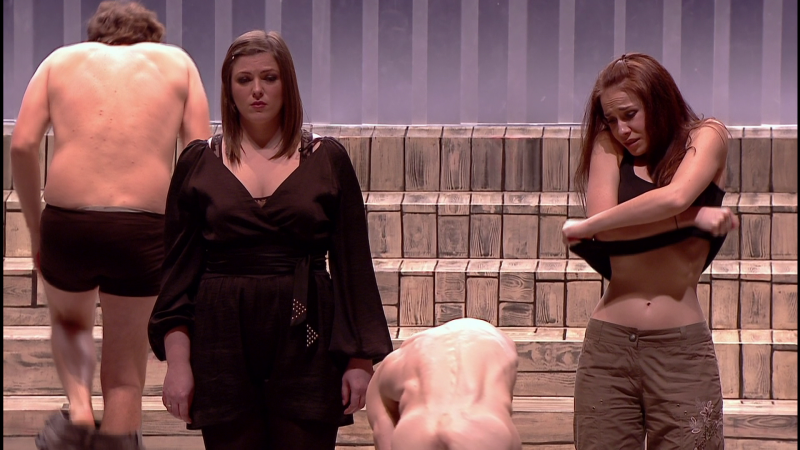
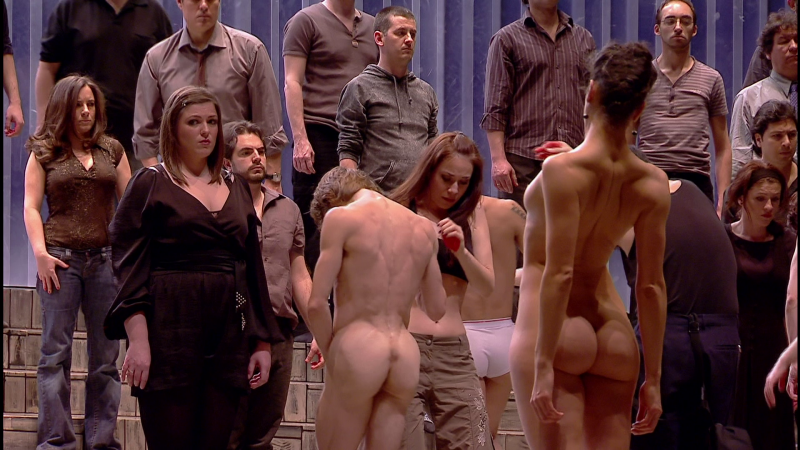
There's a lot more to this show than what is revealed in these screenshots. And everything is delivered with maximum seriousness---not one smile or glimmer of humor in the whole piece. We did a Dance Wonk Worksheet. Every image from Morell is as about as beautiful as it could be. But the pace is too fast (too many separate images) and there are too few whole-stage and whole-body shots. (We wonder what Vincent Bataillon would have done with this.) Still, we can't be too harsh on the video content. The emphasis in this show is more on the innumerable individual actions and antics of the performers and less on the integrity of dance lines through time and space. So we knock the beginning grade of A+ down to A for the hyperactive pace.
There was an official Euroarts trailer for this that was rendered unavailable for unexplained reasons. Below (May 2020) is an amazingly good clip of the whole show which is, we think, the exact record that was published by Euroarts. You need to buy the Euroarts disc to enjoy this properly as the subtitles, missing from the clip below, are an important part of the whole experience: